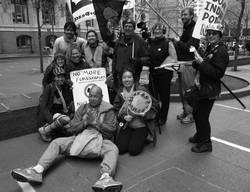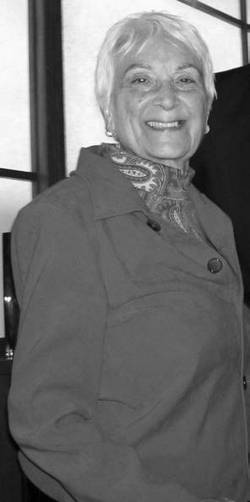 Shut down all 104 nuclear power plants operating in the U.S. to build a nuclear-free future.
Shut down all 104 nuclear power plants operating in the U.S. to build a nuclear-free future.
That is the common goal uniting the participants and supporters of the “No More Fukushimas Peace Walk” who recently walked by the University earlier this month. The walk is a response to the destruction caused by the partial meltdown of the nuclear reactor in Fukushima, Japan, that followed the country’s 8.9-magnitude earthquake and tsunami last March. It seeks to raise awareness about the structural similarities between the Fukushima plant and U.S. plants.
“There’s a possibility that the nuclear plant right where [you] live can have an accident and if [it does] it’s unlike any other industry. It leaves permanent damage; it just takes away hope for life which is what’s happening in Japan,” said Edith Gbur, President of Jersey Shore Nuclear Watch, a Toms River-based coalition created in 2000 that seeks the permanent closing of New Jersey’s Oyster Creek Nuclear Generating Station located just 40 miles from campus. The coalition has partnered with the walk to strengthen the anti-nuclear message.
This year’s walk spanned three states and is scheduled to end today at the nuclear power plant in Brattleboro, VT, known as the Vermont Yankee; it is one of three plants in the northeastern U.S. identified by the walkers as a primary concern due to its structure. The other two include the Indian Point Nuclear Power Plant in Buchanan, NY, and the Oyster Creek Nuclear Generating Station where the walk began on March 3 in Forked River, NJ.
About 15 people comprised the walk’s core and traveled the entire distance; however, the walk attracted as many as 60 people depending on location. Among them was Jun Yasuda, a Buddhist nun from Grafton, N.Y., who founded the peace walk shortly after the Japanese disaster. She has been walking to protest nuclear power since 1978 and has completed various cross-country trips since then.
“After Fukushima, more people [are] listening to the Japanese people’s voice,” she said. “I have to keep [walking]. [Nuclear power] is no solution.”
Other walkers included Buddhist monks and nuns, eyewitnesses to the Japanese earthquake and members of various organizations concerned about the hazards posed by nuclear power plants in the U.S. After 10 hours of walking per day, the walkers ate potluck dinners while listening to various guest speakers, such as the Director of New Jersey’s chapter of the Sierra Club and a sustainable energy specialist among others.
Christian Collins, one of the walk’s coordinators, said that he is more concerned about inspiring a larger anti-nuclear movement than attracting more walkers. “One of the aims of the walk is to re-energize the local activists around the different power plants that we’re visiting,” he commented. “Through the walk we can facilitate communication between local activist groups, [so] we’re bringing [them] together, and helping them to talk to each other [and] learn techniques from each other.”
Contrary to the walk’s purpose, the nation has actually increased its reliance on nuclear power despite a halt in the construction of U.S. nuclear plants during the last 30 years. Nuclear plants produced 20 percent of the nation’s electricity in 2008 which is up from 11 percent in 1980, according to the World Nuclear Association, an international organization that promotes the use of nuclear energy.
Numbers like these have convinced Dr. Bradley Ingebrethsen of the University’s Department of Chemistry, Medical Technology and Physics, that the shutdown of all U.S. nuclear plants is not a realistic short-term goal. He said that it may be possible in the long-term, but not without years of planning to produce a viable alternative form of energy.
“We certainly couldn’t do it immediately,” Ingebrethsen commented. “We have a need for the power that’s produced. You can’t lose 20 percent of your power and not have somewhere else to get it.”
Ingebrethsen added that the nation’s increased use of nuclear power since 1980 is proof that it was once again becoming an acceptable source of energy. However, the recent events in Japan changed that perception.
 “Prior to that disaster, nuclear power was coming back into fashion,” he said. “It relieves the dependence on foreign sources of fossil fuels and it also addresses global warming issues, and people are concerned about that.”
“Prior to that disaster, nuclear power was coming back into fashion,” he said. “It relieves the dependence on foreign sources of fossil fuels and it also addresses global warming issues, and people are concerned about that.”
Still, Gbur sees this 20 percent figure as minimal. “I don’t even think that we need to have a substitute,” she said. “There’s enough energy as it is right now. It’s a myth that nuclear power is needed and that if it shut down there would be a lack of energy.”
Gbur blames the Nuclear Regulatory Commission for preventing the shutdown of the nation’s nuclear plants. The commission is an independent agency created by Congress in 1974 to regulate commercial nuclear power plants and other uses of nuclear materials. Gbur said that the commission has the power to override the desires of state governments that oppose the re-licensing of plants within their boundaries.
“That’s our big problem,” Gbur said. “We have one government agency that can overrule any kind of state or grassroots [movement] on the question of the nuclear plants.” However, Gbur would rather reach out to average citizens than petition the agency because of its strong financial backing. “[With] this peace walk, I think we got further along in reaching people and uniting,” she added. “Getting organizations to organically work together is the best way of uniting.”
The commission has actually failed numerous times in ensuring the safety of the nation’s nuclear power plants, according to The NRC and Nuclear Power Plant Safety in 2010: A Brighter Spotlight Needed. This report was written by the Union of Concerned Scientists: Citizens and Scientists for Environmental Solutions.
The report says that the Indian Point Power Plant was found to have a liner around its refueling cavity that had been leaking since 1993, but the commission chose to ignore the problem. At the Vermont Yankee, the commission’s inspectors apparently ignored regulations requiring the controlled release of radioactive air.
Among a host of other problems, the report also said that the commission identified 27 nuclear reactors lacking the necessary precaution against earthquakes; none of them are located on the West Coast. However, the commission has yet to resolve these existing vulnerabilities.
There is nothing that can be done to make nuclear energy 100 percent safe, said Professor Edward Kelsey, an adjunct professor also in the University’s Department of Chemistry, Medical Technology and Physics. However, he continued that a meltdown at the Oyster Creek Nuclear Generating Station is unlikely to occur or impact the University despite its close proximity.
Instead of leaving the commission with solitary control, Gbur said that she favors a referendum on state ballots that allows voters to decide whether or not nuclear power plants remain active.
“Nuclear plants would not exist without ratepayers and taxpayers,” Gbur commented. “They are subsidized. Our monthly charges pay to keep the plant going and yet we have no voice in whether the plant stays open or shut.”
While this year’s walk focused on just three of the nation’s 104 nuclear plants, Gbur hopes that the walk’s anti-nuclear message will spread. “I think that [Fukushima] gave doubt to the whole idea that nuclear power is safe and that has changed the thinking of people,” she said. “This year we got the feeling that [the movement is spreading].”
“I think [that] since Fukushima there’s a more direct emphasis on the dangers of nuclear power,” Collins added.
PHOTO COURTESY of facebook.com
PHOTO COURTESY of Edith Gbur



